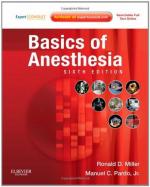|
This section contains 534 words (approx. 2 pages at 300 words per page) |

|
Aesthesia is the depression or numbing of nerve pathways in all or part of the nervous system. The effect of anesthesia is the loss of sensation, principally the loss of pain. Thus, anesthesia functions to keep a patent free from pain during surgery.
A second hallmark of an anesthetic is its reversibility. The loss of sensation induced by an anesthetic is only temporary; the times vary depending on the anesthetic.
Anesthesia has accompanied surgical procedures for hundreds of years. Ether—until relatively recently a popular anesthetic, until its flammable nature proved too dangerous--was first made in 1540. Injectable anesthetics were in use by the mid-seventeenth century, and nitrous oxide (also commonly called laughing gas) was inhaled as both an anesthetic and for social frivolity by the early years of the nineteenth century.
There are four basic categories of anesthesia; general...
|
This section contains 534 words (approx. 2 pages at 300 words per page) |

|


